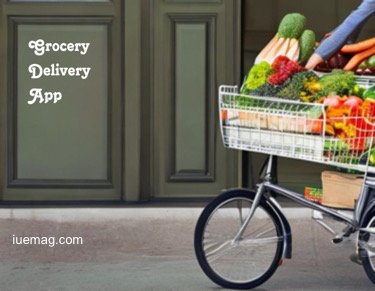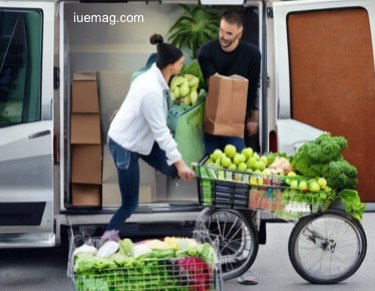

How to Build a Cutting-Edge Grocery Delivery App
 In today's fast-paced world, where convenience and efficiency are highly valued, businesses must adapt to changing consumer preferences. A significant trend that has gained immense popularity in recent years is the use of mobile applications for food and grocery delivery. As the demand for online shopping and contactless deliveries continues to soar, businesses, particularly those in the food and grocery industry, should seriously consider developing their own delivery app to remain competitive and meet the evolving needs of their customers.
In today's fast-paced world, where convenience and efficiency are highly valued, businesses must adapt to changing consumer preferences. A significant trend that has gained immense popularity in recent years is the use of mobile applications for food and grocery delivery. As the demand for online shopping and contactless deliveries continues to soar, businesses, particularly those in the food and grocery industry, should seriously consider developing their own delivery app to remain competitive and meet the evolving needs of their customers.The most compelling reason for businesses to invest in a delivery app is the potential to boost sales and expand their customer base. With a user-friendly mobile app, customers can easily browse through a business's products or menu, place orders, and make online payments with just a few taps on their smartphones. This seamless convenience can result in higher order volumes and repeat purchases, ultimately driving revenue growth. In this article you will learn how to build grocery delivery app.
The Right Type of Grocery App for Your Business
When determining the business model for a grocery delivery app, there are two main options to consider: the single-store model and the aggregator model. Each model has its own set of advantages and disadvantages, which may vary depending on the specific circumstances and needs of the business. Here are some key factors to take into account:
Single-Store Model
Pros:
1. Simpler to set up and manage, as all operations are conducted within a single store's inventory and delivery system.
2. Provides greater control over branding, pricing, and customer experience, as the app represents a specific store or chain.
3. Allows for direct communication and relationship-building with customers, fostering loyalty and repeat business.
4. Can offer a more personalized and tailored shopping experience, with the ability to curate products and promotions based on the store's unique offerings.
Cons:
1. Limited product range and variety compared to aggregator models, as customers can only access products from the specific store or chain.
2. May require more investment in infrastructure and logistics, as the store is responsible for managing its own inventory, warehousing, and delivery operations.
3. May have lower visibility and reach compared to aggregator models, as customers need to download and use a separate app for each store.
Aggregator Model
Pros:
1. Provides access to a wider range of products and multiple stores through a single app, offering greater convenience and choice for customers.
2. Requires less investment in inventory and warehousing, as the aggregator does not own or manage physical stores.
3. Can benefit from economies of scale and bargaining power with suppliers, potentially resulting in better pricing and margins.
4. Can leverage data and analytics to offer personalized recommendations and promotions based on customer preferences and behaviors.
Cons:
1. More complex to set up and manage, as the aggregator needs to establish partnerships and integrate with multiple stores' systems.
2. May have less control over branding and customer experience, as the app represents multiple stores with potentially different standards and practices.
3. Requires effective communication and coordination with partner stores to ensure timely and reliable delivery of products.
4. May face challenges in building customer loyalty and repeat business, as customers may switch between stores within the aggregator app based on price or availability.
Understanding the distinction between the two fundamental types of grocery delivery apps enables you to align your business plan and objectives, allowing you to determine which model is most suitable for your needs.
Things to Know Before Embarking on Grocery Delivery App Development
Developing a grocery delivery app requires careful consideration of various factors to ensure a successful outcome. Here are some essential considerations to keep in mind before diving into grocery app development:
Market Research: Conduct thorough market research to understand the demand, competition, and target audience for grocery delivery services in your specific market. This will help you identify opportunities and challenges, and tailor your app accordingly.
Features and Functionality: Determine the features and functionality you want to include in your app, such as product catalog, shopping cart, payment gateway, delivery tracking, customer reviews, and promotions. Prioritize features that align with your business goals and customer needs. We'll tell you more about these features below.
Technology Stack: Choose the right technology stack for your app, including the programming language, frameworks, libraries, and databases. Consider factors such as scalability, security, and ease of maintenance when making technology decisions.
User Experience: Pay close attention to the user experience of your app, as it plays a critical role in attracting and retaining customers. Ensure that the app is easy to use, visually appealing, and provides a seamless shopping experience from browsing to payment and delivery.
Logistics and Operations: Consider the logistics and operations aspects of grocery delivery, such as inventory management, order fulfillment, and last-mile delivery. Plan for efficient and reliable logistics operations to ensure smooth functioning of your app.
Security and Privacy: Implement robust security measures to protect customer data, payment information, and other sensitive information. Compliance with data privacy regulations such as GDPR and CCPA is also essential.
7 Key Features Every Grocery Delivery App Needs
When it comes to a grocery app, there are several essential features that are a must-have for providing a seamless and convenient shopping experience for customers, while also streamlining business operations.
1. Product Catalog: A comprehensive and intuitive product catalog that enables customers to effortlessly browse, search, view product details, and add items to their cart.
2. Shopping Cart and Checkout: A secure and seamless shopping cart and checkout process that allows customers to easily add items to their cart, specify delivery preferences, and complete payments with peace of mind.
3. Payment Gateway: A reliable and secure payment gateway that supports multiple payment options, including credit cards, debit cards, mobile wallets, and other popular methods for maximum convenience and flexibility.
4. Delivery Tracking: Real-time delivery tracking that empowers customers to track their orders, view estimated delivery times, and receive timely notifications for order updates, ensuring a smooth and transparent delivery experience.
5. Personalized Accounts: User-friendly accounts that allow customers to create and manage profiles, view order history, save favorite products.
6. Reviews and Ratings: Customer reviews and ratings for products and delivery service, helping customers make informed decisions and providing feedback for improvement.
7. Social Sharing and Referral Program: Social sharing features that allow customers to share their shopping experiences on social media and refer friends and family to the app, creating a referral program that incentivizes word-of-mouth marketing.
Development and Design Tips for Grocery App
 Begin by clearly defining the purpose of your app and identifying your target audience. This will guide you in making informed decisions throughout the development and design process.
Begin by clearly defining the purpose of your app and identifying your target audience. This will guide you in making informed decisions throughout the development and design process.Conduct comprehensive market research to understand the demand for grocery delivery services in your target market, identify competitors, and gather insights on user preferences and expectations.
Select the appropriate platform for your app, such as iOS, Android, or both, based on your target audience and business goals. Consider factors like ease of development, user base, and app store guidelines.
Determine the key features and functionality you want to include in your app, such as product catalog, shopping cart, payment gateway, delivery tracking, and user accounts. Prioritize features that align with your app's goals and user needs.
Create a visually appealing and user-friendly UI that provides a seamless and enjoyable experience for users. Pay attention to navigation, layout, color scheme, and typography to create an intuitive and visually appealing interface.
Ensure the implementation of robust security measures to protect customer data, payment information, and other sensitive information. Comply with data privacy regulations and use encryption and authentication methods to ensure the security of the app and user data.
Optimize the app's performance by minimizing loading times, optimizing database queries, and utilizing caching techniques. This will enhance the overall user experience and ensure smooth app performance.
Conduct comprehensive testing to identify and fix any bugs, glitches, or usability issues in your app before launching it to the public. Test the app on different devices, platforms, and network conditions to ensure compatibility and performance.
Continuously gather feedback from users and make improvements to your app based on their input. Keep up with industry trends, technological advancements, and user preferences, and regularly update your app to stay relevant and competitive in the market.
Pay attention to branding and marketing aspects of your app, such as creating a unique brand identity, developing a marketing strategy, and promoting your app through various channels to attract users and drive app downloads.
By following these guidelines, you can create a successful and user-friendly grocery delivery app that meets the needs of your target audience and provides a seamless and convenient shopping experience.
Conclusion:
A grocery delivery app presents a compelling business opportunity for multiple reasons. It offers unparalleled convenience to customers, enabling them to easily order groceries from the comfort of their homes, saving them valuable time and effort. This convenience factor is particularly attractive to busy customers who prioritize efficient and convenient shopping options.What is more important, a grocery delivery app has the potential to significantly expand a business's market reach beyond its physical store location.
By harnessing the power of mobile technology, businesses can access a wider audience, including urban dwellers, working professionals, and busy families who prefer the convenience of online grocery shopping. This expanded market reach can result in higher sales and revenue potential for the business.
Copyrights © 2025 Inspiration Unlimited - iU - Online Global Positivity Media
Any facts, figures or references stated here are made by the author & don't reflect the endorsement of iU at all times unless otherwise drafted by official staff at iU. A part [small/large] could be AI generated content at times and it's inevitable today. If you have a feedback particularly with regards to that, feel free to let us know. This article was first published here on 20th April 2023.
Overthinking? Uninspired? Brain Fogged?
Let's Reset That! Try iU's Positivity Chat NOW!

All chats are end-to-end encrypted by WhatsApp and won't be shared anywhere [won't be stored either].


